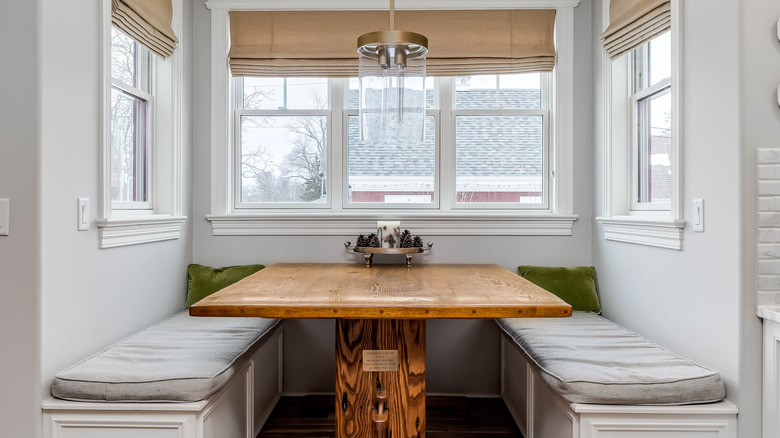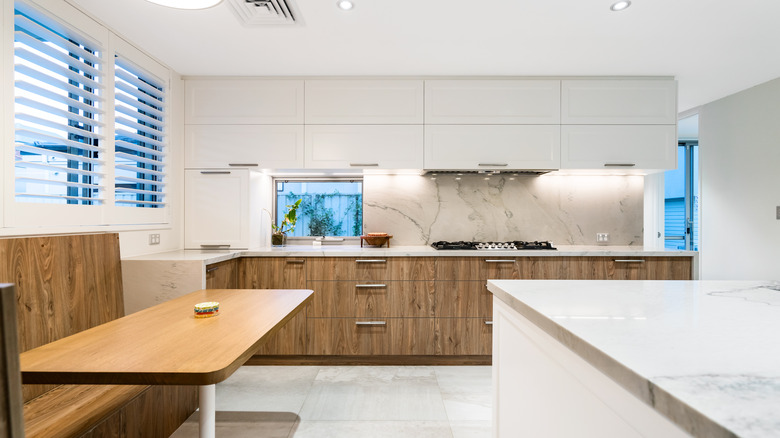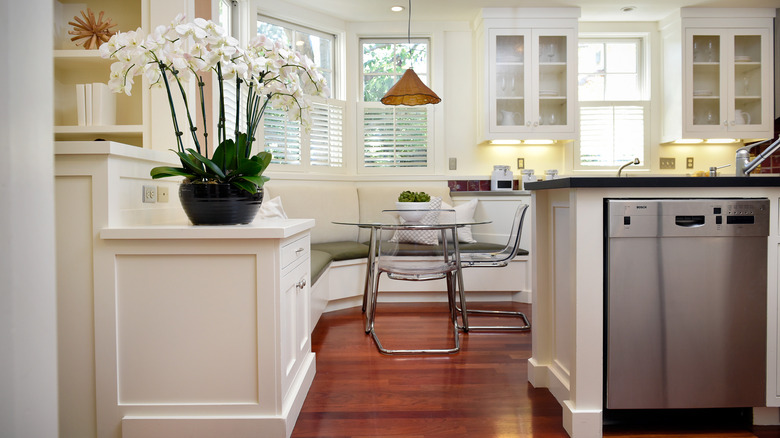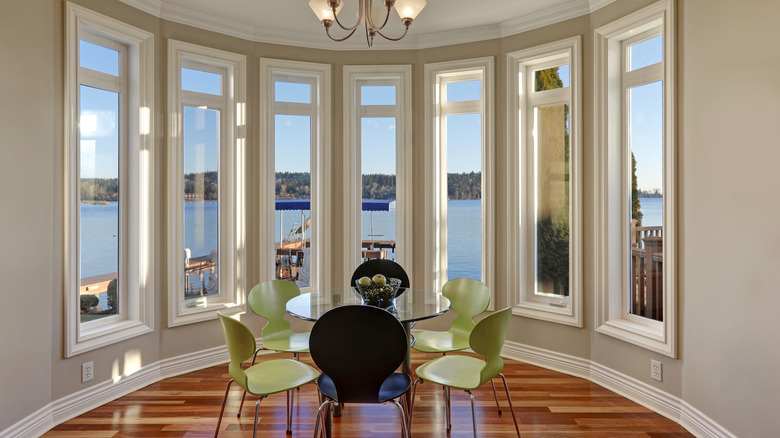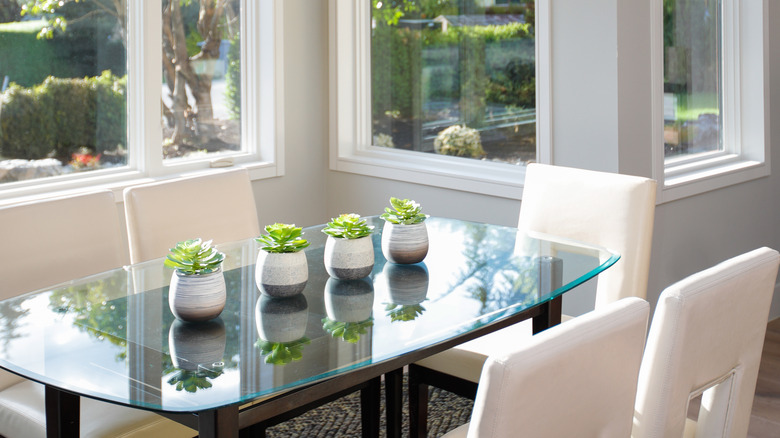How Much Does It Cost To Build A Breakfast Nook From Scratch
Building a breakfast nook is a great option for homeowners looking to add a personalized touch to their kitchens. The Spruce, Homedit, and Real Homes all note that a breakfast nook is a useful addition to a property and can be built without the help of a professional. It's a task that you and your loved ones can complete together and enjoy as a family for many years to come.
Homedit estimates that a new breakfast nook built against an existing wall or bay window will cost about $150 to $300 per square foot — for a total ranging from roughly $850 to $8,000.
Of course, hiring a carpenter to complete the build is also possible. Thumbtack estimates that a carpenter typically charges $35 to $90 per hour, so adding this figure to the cost of materials will give you a general price range for a job that brings a professional on board.
Whatever method you decide, a breakfast nook is a project that's entirely approachable for many homeowners. Adding this feature can bring a central gathering space to your home that is both fun and functional.
Factors for cost
With any carpentry project, there are two primary features that weigh on the cost of the job — the materials and labor charges. You should also consider the cost of any tools you may need.
Materials are the most important factor
The largest expense in this home improvement project is the materials. At a minimum, you'll require a set of 2x4s and 1x4s and plywood sheeting to frame the installation's exterior. A basic design will call for you to construct simple boxes from the lumber, then add siding cut from the plywood.
However, homeowners often choose to make their nook space more polished than this. Adding hinges will allow you to open the completed box from the top, and drawer hardware will give you an easy pop-out storage option underneath the seating space.
You can select basic lumber options or higher-grade wood products for the project, depending on your needs for the finish. Lower-grade wood is often just as good for the interior sections. The Spruce suggests using a veneer finished plywood to provide a sleek visual appearance for the outward-facing sections. You should also add a wood stain and polyurethane coating to protect the new installation from spills, chips, and other damage. Add padded cushions, small accent pillows, or other details to finish the build.
Labor costs play a hefty role if you hire a professional
Any home improvement project that uses the expertise of a professional will cost more. Labor in the carpentry and home contracting space can range from $35 to $90 per hour, according to Thumbtack. HomeAdvisor also notes that carpenters may charge a consultation fee and additional costs to reimburse for travel. However, a carpenter is a professional wood crafter, and their skills will surpass the woodworking chops of the average homeowner. The decision to use a carpenter for this installation is important. Homeowners who want to introduce a luxury element to the kitchen — or are unable to perform the fabrication themselves — will want to consult with a professional in the field.
But for homeowners thinking of going it alone, the price reduction can be substantial. You will eliminate the added labor costs and can manage the purchases of supplies, avoiding any potential markups that you might pay on a professional quote.
Supplies for a DIY build run the gamut
In addition to the lumber, fasteners, paint, and other materials that you'll need, you may need to supplement your toolbox to complete this project.
You'll need a miter saw, a drill, and a circular saw or jigsaw. The Spruce also recommends using a table saw to cut larger pieces of wood with ease and a nailer to make the assembly run smoothly. Plus, adding these tools to your toolbox can give you that extra push when it comes time to think about the next DIY opportunity.
Additional costs
While a breakfast nook is a straightforward project, there are some additions to consider.
Furniture additions may be required to support the new space
After completing construction, you'll likely need a few new chairs or a fresh table to fit into the space more naturally. Changes to your kitchen and dining space layout often warrant alterations to the furniture. Circle Furniture estimates that it can cost between $12,500 and $15,000 for a completely new set of kitchen furniture, but you will likely only require a few staple pieces to fit in with your existing decor.
Decorations make the space feel like home
Adding decorative elements will help tie the space together and incorporate your nook into the preexisting areas of the kitchen. Homes & Gardens suggests the installation of colorful wallpaper to make the space feel vibrant and lively. The outlet also suggests mixing light and dark tones to create a warm feeling throughout the kitchen. A mixed color gradient helps set the tone of the area and provides a unique feel that can spice up the new addition and make it feel welcoming.
Hardwood accents might be on your mind
Some homeowners want to install a simple breakfast nook, paint it, and then start using the space. Others might opt for a wooden finish, which can be elevated with specialized hardwood accents. Hardwood edges can frame the seating area and create a more elegant overall feel to the addition. Hardwoods come in a variety of textures, colors, and grain patterns, so you have a plethora of options when it comes to adding this finishing touch. Hardwood trim is a unique element that can make all the difference in the look and feel of the finished product.
Why you need a breakfast nook
The addition of a breakfast nook can dramatically change the layout of your kitchen. This feature is loved by homeowners who want a vibrant, open atmosphere.
A breakfast nook adds additional seating and table area without sacrificing mobility
Furnishing Tips reports that homeowners might want to create a breakfast nook to move the primary kitchen seating space away from the main arteries of the kitchen. This addition often goes against a wall or a bar space on the outside of a kitchen island. Since it tends to be tucked away, it keeps the main walkways free and open.
Breakfast nooks create a complement to open environment kitchens
Another fantastic feature of the breakfast nook is that it works well in an open-concept kitchen (via Custom Home Group). An open plan provides for a lighter feeling throughout the home. It can be great for homeowners who want to shift furniture and decorations around often, to create a continually refreshed look. Creating a dedicated nook space for eating, homework, games, and discussion will be great for your open-concept kitchen.
Benefits of a breakfast nook
From greater storage potential to added social space, a breakfast nook will give you more use out of your kitchen.
A breakfast nook adds to the integrated storage in your kitchen
Storage is one of the essential features of a functional kitchen, yet many homeowners find that their cooking areas become increasingly cluttered over time. The storage potential of a breakfast nook is an added bonus. The benches can easily accommodate pull-out drawers or a chest-style hinge that turns the seating area into a lid for storage access.
This space acts as a versatile and communal dining and work area
The kitchen is one of the most used rooms in any home. The Ladders shares a University of California study that suggests that modern families spend a considerable amount of their time in the kitchen and living room and little time elsewhere in their homes. The kitchen, in particular, is a space that supports dining, work and school projects, and so much more. Focusing your home improvement efforts on an area with heavy usage is the best use of your time and money.
